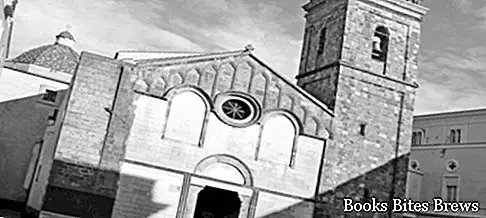What to see in Iglesias, itinerary including the main monuments and places of interest, including the Cathedral of Santa Chiara, the Pisan walls, the Salvaterra Castle and the Mining Museum.
Tourist information
Located in the mining basin of the Rio Cixerri, in the middle of the mountainous region of the Inglesiente, Iglesias was already active in Roman times for the mines located in its territory, also it was part of the Grand Duchy of Cagliari before passing under the Pisan republic, which provoked an increase in the extraction of iron, silver, lead and zinc.
In 1324 it was conquered by the Aragonese, who made it a fortified city.
Subsequently its mining activities were increased by the Savoy and Quintino Sella.
The Cathedral of Santa Chiara, in Romanesque-Gothic style and dating back to the end of the thirteenth century, shows a facade with a motif of arches and a rose window flanked by two blind arches, while the bell tower is only partially original.
Inside, interventions from the Aragonese school made in the sixteenth century can be observed, such as the magnificent cross-shaped coverage of the single nave.
At the top of the hill you can see the remains of the walls, built by the Pisans in the thirteenth century, in addition to the fourteenth century Castle of Salvaterra, heavily remodeled in later periods.
The Gothic church of San Francesco, the result of the reconstruction completed between the fifteenth and sixteenth centuries, has a single nave interior with Gothic arches.
The mining museum, housed in the mining technical institute, includes a rich collection of minerals, fossils and nuragic finds.
What see
The Church of Our Lady of Valverde, completed in the fourteenth century, is characterized by a simple facade and an interior where, in the presbytery area, there are magnificent cross vaults built at the end of the sixteenth century.
Among the excursions to do in the surroundings include that to the Grotta di San Giovanni, located 14 km away from the medieval village of Domusnovas.
Recommended readings- Castelsardo (Sardinia): what to see in the medieval village
- Sardinia: Sunday day trips
- Muravera (Sardinia): what to see
- Gulf of Marinella (Sardinia): what to see
- Cala Gonone (Sardinia): what to see
The cave was originated by erosion phenomena due to the San Giovanni stream, which still flows inside in the spring and autumn.
At 52 km there is Guspini, a town located on the western border of the Campidano, which was an important nuragic center, as evidenced by various nuraghes and tombs of the giants found in its territory.
In the inhabited center there is the fifteenth-century Church of San Nicola di Mira, characterized by Gothic-Aragonese forms and having a crenellated facade with a remarkable rose window.
The Temple of Antas, located 20 km away, is a Punic sanctuary built to celebrate the god Sid and transformed in the third century into a temple dedicated to the Sardus Pater.
The podium and some columns of the pronaos dominated by an architrave are still visible, as well as the massive pillars of the cell.
Villacidro is a hilly town 40 km away, known for its extensive citrus groves and for being a renowned tourist resort.
The parish church is characterized by a bell tower and an interior with particular Gothic-Aragonese forms dating back to the sixteenth century.




